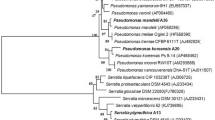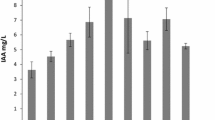Abstract
Microbial metabolites in rhizosphere soil are important to plant growth. In this study, microbial diversity in blueberry plant rhizosphere soil was characterized using high-throughput amplicon sequencing technology. There were 11 bacterial phyla and three fungal phyla dominating in the soil. In addition, inorganic-phosphate-solubilizing bacteria (iPSB) in the rhizosphere soil were isolated and evaluated by molybdenum-antimony anti-coloration method. Their silicate solubilizing, auxin production, and nitrogen fixation capabilities were also determined. Eighteen iPSB in the rhizosphere soil strains were isolated and identified as Buttiauxella, Paraburkholderia and Pseudomonas. The higher phosphorus-solubilizing capacity and auxin production in blueberry rhizosphere belonged to genus Buttiauxella sp. The strains belong to genus Paraburkholderia had the same function of dissolving both phosphorus and producing auxin, as well as silicate and nitrogen fixation. The blueberry seeds incubated with the strains had higher germination rates. The results of this study could be helpful in developing the plant growth-promoting rhizobacteria (PGPR) method for enhancing soil nutrients to blueberry plant.





Similar content being viewed by others
Data Availability
All data have been submitted in the paper.
References
Massarotto G, Barcellos T, Garcia CS, Brandalize AP, Moura S, Schwambach J, Henriques JAP, Roesch-Ely M (2016) Chemical characterization and cytotoxic activity of blueberry extracts (cv. Misty) cultivated in Brazil. J Food Sci 81:H2076–H2084. https://doi.org/10.1111/1750-3841.13385
Miller K, Feucht W, Schmid M (2019) Bioactive compounds of strawberry and blueberry and their potential health effects based on human intervention studies: a brief overview. Nutrients 11:1510–1520. https://doi.org/10.3390/nu11071510
Yurgel SN, Nearing JT, Douglas GM, Langille MG (2019) Metagenomic functional shifts to plant induced environmental changes. Front Microbiol 10:1682–1691. https://doi.org/10.3389/fmicb.2019.01682
Baudoin E, Benizri E, Guckert A (2003) Impact of artificial root exudates on the bacterial community structure in bulk soil and maize rhizosphere. Soil Bio Biochem 35:1183–1192. https://doi.org/10.1016/S0038-0717(03)00179-2
Li LJ, Wang ST, Li XZ, Li TZ, He XH, Tan Y (2018) Effects of Pseudomonas chenduensis and biochar on cadmium availability and microbial community in the paddy soil. Sci Total Environ 11(640–641):1034–1043. https://doi.org/10.1016/j.scitotenv.2018.05.287
Dennis PG, Miller AJ, Hirsch PR (2010) Are root exudates more important than other sources of rhizodeposits in structuring rhizosphere bacterial communities? FEMS Microbiol Ecol 72:313–327. https://doi.org/10.1111/j.1574-6941.2010.00860.x
Zhang S, Wang Y, Sun L, Qiu C, Ding Y, Gu H, Wang L, Wang Z, Ding Z (2020) Organic mulching positively regulates the soil microbial communities and ecosystem functions in tea plantation. BMC Microbiol 20:103–112. https://doi.org/10.1186/s12866-020-01794-8
Richardson AE, Simpson RJ (2011) Soil microorganisms mediating phosphorus availability update on microbial phosphorus. Plant Physiol 156:989–996. https://doi.org/10.1104/pp.111.175448
Elser JJ, Bracken ME, Cleland EE, Gruner DS, Harpole WS, Hillebrand H, Ngai JT, Seabloom EW, Shurin JB, Smith JE (2007) Global analysis of nitrogen and phosphorus limitation of primary producers in freshwater, marine and terrestrial ecosystems. Ecol Lett 10:1135–1142. https://doi.org/10.1111/j.1461-0248.2007.01113.x
Kochian LV (2012) Plant nutrition: rooting for more phosphorus. Nature 488:466–477. https://doi.org/10.1038/488466a
Bianco C, Defez R (2010) Improvement of phosphate solubilization and Medicago plant yield by an indole-3-acetic acid-overproducing strain of Sinorhizobium meliloti. Appl Environ Microbiol 76:4626–4632. https://doi.org/10.1128/AEM.02756-09
Wang XH, Wang CD, Sui JK, Liu ZY, Li Q, Ji C, Song X, Hu YR, Wang CQ, Sa R, Zhang JM, Du JF, Liu XL (2018) Isolation and characterization of phosphofungi, and screening of their plant growth-promoting activities. AMB Express 8:63–71. https://doi.org/10.1186/s13568-018-0593-4
Fujii Y, Akihiro F, Syuntro H (2004) Rhizosphere soil method: a new bioassay to evaluate allelopathy in the field. 3rd Australian New Zealand Soils Conference: Novel Approaches. Australia: Charles Sturt University Press, 490–492.
Wang MJ, Sun HY, Xu L, Xu ZM (2021) Bacterial diversity in tea plant (Camellia sinensis) rhizosphere soil from Qinling Mountains and its relationship with environmental elements. Plant Soil 460:403–415. https://doi.org/10.1007/s11104-020-04822-8
Saitou N, Nei M (1987) The neighbor-joining method: a new method for reconstructing phylogenetic trees. Mol Biol Evol 4:406e425. https://doi.org/10.1093/oxfordjournals.molbev.a040454
Cox JA (1972) Electrochemical method for the determination of phosphate in natural water. Water Research Center Research Report NO. 61. https://hdl.handle.net/2142/90404
da Silva JF, da Silva TR, Escobar IEC, Fraiz ACR, Dos Santos JWM, do Nascimento TR, Dos Santos JMR, Peters SJW, de Melo RF, Signor D (2018) Screening of plant growth promotion ability among bacteria isolated from field-grown sorghum under different managements in Brazilian drylands. World J Microbiol Biotechnol 34:186–193. https://doi.org/10.1007/s11274-018-2568-7
Adrain JM, Westrop SR, Chatterton DEB, Ramskild L (2000) Silurian trilobite alpha diversity and the end-Ordovician mass extinction. Paleobiology 26:625–646. https://www.jstor.org/stable/2666103
Chao A (1984) Non-parametric estimation of the number of classes in a population. Scand J Stat 11:265–270
Colwell RK, Coddington JA (1994) Estimating terrestrial biodiversity through extrapolation. Philos Trans R Soc Lond B Biol Sci 345:101–118. https://doi.org/10.1098/rstb.1994.0091
Camp WH (1945) The North American blueberries with notes on other groups of vacciniaceae. Brittonia 5:203–275. https://doi.org/10.2307/2804880
Vandenkoornhuyse P, Quaiser A, Duhamel M, Le Van A, Dufresne A (2015) The importance of the microbiome of the plant holobiont. New Phytol 206:1196–1206. https://doi.org/10.3389/fmicb.2014.00491
Yurgel SN, Douglas GM, Comeau AM, Mammoliti M, Dusault A, Percival D, Langille MGI (2017) Variation in bacterial and eukaryotic communities associated with natural and managed wild blueberry habitats. Phytobiomes 1:102–113. https://doi.org/10.1094/PBIOMES-03-17-0012-R
Yurgel SN, Douglas GM, Dusault A, Percival D, Langille MG (2018) Dissecting community structure in wild blueberry root and soil microbiome. Front Microbiol 9:1187–1196. https://doi.org/10.3389/fmicb.2018.01187
Li J, Mavrodi OV, Hou J, Blackmon C, Babiker EM, Mavrodi DV (2020) Comparative Analysis of Rhizosphere Microbiomes of Southern Highbush Blueberry (Vaccinium corymbosum L.), Darrow's Blueberry (V. darrowii Camp), and Rabbiteye Blueberry (V. virgatum Aiton). Front Microbiol 11:370. https://doi.org/10.3389/fmicb.2020.00370
Pester M, Schleper C, Wagne M (2011) The Thaumarchaeota: an emerging view of their phylogeny and ecophysiology. Curr Opin Microbiol 14:300–306. https://doi.org/10.1016/j.mib.2011.04.007
Wang J, Shi X, Zheng C, Suter H, Huang Z (2021) Different responses of soil bacterial and fungal communities to nitrogen deposition in a subtropical forest. Sci Total Environ 10;755(Pt 1):142449. https://doi.org/10.1016/j.scitotenv.2020.142449
Ji M, van Dorst J, Bissett A, Brown MV, Palmer AS, Snape I (2016) Microbial diversity at Mitchell Peninsula, eastern Antarctica: a potential biodiversity “hotspot.” Polar Biol 39:237–249. https://doi.org/10.1007/s00300-015-1776-y
Holland-Moritz H, Stuart J, Lewis LR, Miller S, Mack MC, McDaniel SF, Fierer N (2018) Novel bacterial lineages associated with boreal moss species. Environ Microbiol 20:2625–2638
Ward LM, Cardona T, Holland-Moritz H (2019) Evolutionary implications of anoxygenic phototrophy in the bacterial phylum candidatus Eremiobacterota (WPS-2). Front Microbiol 10:1658–1668. https://doi.org/10.3389/fmicb.2019.01658
Gu Y, Wang Y, Wang P, Wang C, Ma J, Yang X, Ma D, Li M (2020) Study on the diversity of fungal and bacterial communities in continuous cropping fields of Chinese chives (Allium tuberosum). Biomed Res Int 2020:3589758. https://doi.org/10.1155/2020/3589758
Wang R, Cao B, Sun Q, Song L (2020) Response of grass interplanting on bacterial and fungal communities in a jujube orchard in Ningxia, northwest China. Heliyon 6:e03489. https://doi.org/10.1016/j.heliyon.2020.e03489
Cline LC, ZaK DR (2015) Soil microbial communities are shaped by plant-driven changes in resource availability during secondary succession. Ecology 96:3374–3385. https://doi.org/10.1890/15-0184.1
Ma Z, Zhao W, Zhao C, Wang D, Liu M, Li D, Liu Q (2018) Plants regulate the effects of experimental warming on the soil microbial community in an alpine scrub ecosystem. PLoS ONE 13:e0195079. https://doi.org/10.1371/journal.pone.0195079
Hancock JF (2006) Highbush blueberry breeders. HortScience 41:20–21
Cardinale M, Grube M, Erlacher A, Quehenberger J, Berg G (2015) Bacterial networks and co-occurrence relationships in the lettuce root microbiota. Environ Microbiol 17:239–252. https://doi.org/10.1111/1462-2920.12686
Perez-Jaramillo JE, Carrion VJ, De Hollander M, Raaijmakers JM (2018) The wild side of plant microbiomes. Microbiome 6:143. https://doi.org/10.1186/s40168-018-0519-z
Harris SL, Pelaez CA, Shank EA (2019) Monitoring bacterial colonization and maintenance on Arabidopsis thaliana roots in a floating hydroponic system. J Vis Exp 5:147–158. https://doi.org/10.3791/59517
Kaur G, Reddy MS (2015) Effects of phosphate-solubilizing bacteria, rock phosphate and chemical fertilizers on maize–wheat cropping cycle and economics. Pedosphere 25:428–437. https://doi.org/10.1016/S1002-0160(15)30010-2
Gao ZH, Ruan SL, Huang YX, Lv YY, Qiu LH (2019) Paraburkholderia phosphatilytica sp. nov., a phosphate-solubilizing bacterium isolated from forest soil. Int J Syst Evol Microbiol 69:196–202. https://doi.org/10.1099/ijsem.0.003129
Tang A, Haruna AO, Majid NMA, Jalloh MB (2020) Effects of selected functional bacteria on maize growth and nutrient use efficiency. Microorganisms 8:854–861. https://doi.org/10.3390/microorganisms8060854
Ferragut C, Izard D, Gavini F, Lefebvre B, Leclerc H (1981) Buttiauxella, a new genus of the family Enterobacteriaceae. Zbl Bakt Mik Hyg 2:33–44. https://doi.org/10.1016/S0721-9571(81)80016-65
Müller HE, Brenner DJ, Fanning GR, Grimont PAD, Kämpfer P (1996) Emended description of Buttiauxella agrestis with recognition of six new species of Buttiauxella and two new species of Kluyvera: Buttiauxella ferragutiae sp. nov., Buttiauxella gaviniae sp. nov., Buttiauxella brennerae sp. nov., Buttiauxella izardii sp. nov., Buttiauxella noackiae sp. nov., Buttiauxella warmboldiae sp. nov., Kluyvera cochleae sp. nov., and Kluyvera georgiana sp. nov. Int J Syst Evol Microbiol 46:50–63. https://doi.org/10.1099/00207713-46-1-50
Sawana A, Adeolu M, Gupta RS (2014) Molecular signatures and phylogenomic analysis of the genus Burkholderia: proposal for division of this genus into the emended genus Burkholderia containing pathogenic organisms and a new genus Paraburkholderia gen. nov. harboring environmental species. Front Genet 5:429–436. https://doi.org/10.3389/fgene.2014.00429
Ahmad M, Zahir ZA, Nazli F, Akram F, Arshad M, Khalid M (2014) Effectiveness of halo-tolerant, auxin producing Pseudomonas and Rhizobium strains to improve osmotic stress tolerance in mung bean (Vigna radiata L.) Braz. J Microbiol 44:1341–1348. https://doi.org/10.1590/s1517-83822013000400045
Alaylar B, Güllüce M, Karadayi M, Isaoglu M (2019) Rapid detection of phosphate-solubilizing bacteria from agricultural areas in Erzurum. Curr Microbiol 76:804–809. https://doi.org/10.1007/s00284-019-01688-7
Fox AR, Soto G, Valverde C, Russo D, Lagares JA, Zorreguieta A, Alleva K, Pascuan C, Frare R, Mercado-Blanco J, Dixon R, Ayub ND (2016) Major cereal crops benefit from biological nitrogen fixation when inoculated with the nitrogen-fixing bacterium Pseudomonas protegens Pf-5 X940. Environ Microbiol 18:3522–3534. https://doi.org/10.1111/1462-2920.13376
Dong X, Lv L, Wang WJ, Liu YZ, Yin CH, Xu QQ, Yan H, Fu JX, Liu XL (2019) Differences in distribution of potassium-solubilizing bacteria in forest and plantation soils in Myanmar. J Environ Res Public Health 16:700–710. https://doi.org/10.3390/ijerph16050700
Debnath SC, Goyali CJ (2020) In vitro propagation and variation of antioxidant properties in Micropropagated Vaccinium berry plants-a review. Molecules 25:788–794. https://doi.org/10.1016/S0038-0717(03)00179-2
Abbas F, Hammad HM, Ishaq W, Farooque AA, Bakhat HF, Zia Z, Fahad S, Farhad W, Cerdà A (2020) A review of soil carbon dynamics resulting from agricultural practices. J Environ Manag 268:110319–111329. https://doi.org/10.1016/j.jenvman.2020.110319
Wang HH, Ren TB, Müller K, Van Zwieten L, Wang HL, Feng HL, Xu CS, Yun F, Ji XM, Yin QY, Shi HZ, Liu GS (2021) Soil type regulates carbon and nitrogen stoichiometry and mineralization following biochar or nitrogen addition. Sci Total Environ 753:141645. https://doi.org/10.1016/j.scitotenv.2020.141645
Funding
This study was supported by the Foundation of Young Scientist Empowerment Project of Shaanxi Association of Science and Technology (20200206), Natural Science Basic Research Program of Shaanxi (2021JQ-755), and the Foundation of Shaanxi University of Technology (SLG1809), China.
Author information
Authors and Affiliations
Contributions
All authors contributed to the study conception and design. Material preparation, data collection and analysis were performed by MW, HS and ZX. The first draft of the manuscript was written by MW and all authors commented on previous versions of the manuscript. All authors read and approved the final manuscript.”
Corresponding author
Ethics declarations
Competing interest
The authors have no relevant financial or non-financial interests to disclose.
Ethical Approval
Not applicable.
Consent to Participate
Not applicable.
Consent for Publication
Not applicable.
Additional information
Publisher's Note
Springer Nature remains neutral with regard to jurisdictional claims in published maps and institutional affiliations.
Appendix
Appendix
Rights and permissions
Springer Nature or its licensor holds exclusive rights to this article under a publishing agreement with the author(s) or other rightsholder(s); author self-archiving of the accepted manuscript version of this article is solely governed by the terms of such publishing agreement and applicable law.
About this article
Cite this article
Wang, M., Sun, H. & Xu, Z. Analysis of Blueberry Plant Rhizosphere Bacterial Diversity and Selection of Plant Growth Promoting Rhizobacteria. Curr Microbiol 79, 331 (2022). https://doi.org/10.1007/s00284-022-03031-z
Received:
Accepted:
Published:
DOI: https://doi.org/10.1007/s00284-022-03031-z






